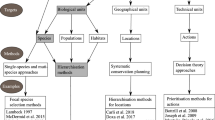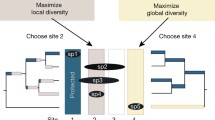Abstract
Despite widely acknowledged handicaps of the species approach to identifying priority conservation areas, many workers continue to use these flawed techniques as the backbone of their analyses. Species-based approaches address only a small part of biological diversity by ignoring different levels of organisation as well as the functional linkages among these levels. These data are often biased and incomplete and are often used in preference to data dealing with higher biological levels of organisation though the latter may be readily available. Within the framework of Noss's [(1990) Conservation Biology 4: 355–364] hierarchical definition of biodiversity (and Scott etal. [(1993) Wildlife Monographs 123: 1–31] gap analysis), we propose a top-down model dealing with broad organisational levels first, and finer-scale species distributions last. Note that we do not discard the latter approach, but merely argue for its use at a stage when, in our opinion, it adds most to the value of the prioritisation exercise. The model is flexible so that additional information, particularly those related to threats to biological diversity, can be added when they are available.
Similar content being viewed by others
References
Acocks JPH (1988) Veld Types of South Africa. Botanical Research Institute, South Africa
Austin MP and Heyligers PC (1989) Vegetation survey design for conservation: gradsect sampling in forests in north-eastern New South Wales. Biological Conservation 50: 13–32
Beissinger SR, Steadman EC, Wohlgenant T, Blate G and Zack S (1996) Null models for assessing ecosystem conservation priorities: threatened birds as titers of threatened ecosystems in South America. Conservation Biology 10: 1343–1352
Camm JD, Polasky S, Solow A and Csuti B (1996) A note on optimal algorithms for reserve site selection. Biological Conservation 78: 353–355
Caicco SL, Scott JM, Butterfield B and Csuti B (1995) A gap analysis of the management status of the vegetation of Idaho (USA). Conservation Biology 9: 498–511
Cowling RM and Bond WJ (1991) How small can reserves be? An empirical approach in Cape Fynbos, South Africa. Biological Conservation 58: 243–256
Csuti B and Crist P (1997) Methods for developing terrestrial vertebrate distribution maps for GAP analysis. In: A Handbook for Conducting GAP Analysis. University of Idaho, Moscow, www.gap.uidaho.edu/gaphandbook/vert/vert.htm
Csuti B, Polasky S, Williams PH, Pressey RL, Camm JD, Kershaw M, Kiester AR, Downs B, Hamilton R, Huso M and Sahr K (1997) A comparison of reserve selection algorithms using data on terrestrial vertebrates in Oregon. Biological Conservation 80: 83–97
Davis FW and Stoms DM (1996) Sierran vegetation: A gap analysis. In: Sierra Nevada Ecosystem Project: Final Report to Congress, Vol. ii, Assessments and scientific basis for management options, pp 671–689. University of California, Centers for Water & Wildland Resources, Davis
Dinerstein E and Wikramanayake ED (1993) Beyond `hotspots': how to prioritise investments to conserve biodiversity in the Indo-Pacific region. Conservation Biology 7: 53–65
Edwards TC, Deshler ET, Foster D and Moisen GG (1996) Adequacy of wildlife habitat relation models for estimating spatial distributions of terrestrial vertebrates. Conservation Biology 10: 263–270
Ehrlich PL and Wilson EO (1991) Biodiversity studies: science and policy. Science 253: 758–762
Faith DP and Walker PA (1996) Environmental diversity: on the best-possible use of surrogate data for assessing the relative biodiversity of a set of areas. Biodiversity and Conservation 5: 399–415
Fernside PM and Ferraz J (1995) A conservation gap analysis of Brazil's Amazonian vegetation. Conservation Biology 9: 1134–1147
Franklin JF (1993) Preserving biodiversity: species, ecosystems, or landscapes? Ecological Applications 3: 202–205
Freitag S and van Jaarsveld AS (1995) Towards conserving regional mammalian species diversity: a case study and data critique. South African Journal of Zoology 30: 136–144
Freitag S, Nicholls AO and van Jaarsveld AS (1996) Nature reserve selection in the Transvaal, South Africa: what data should we be using? Biodiversity and Conservation 5: 685–698
Freitag S and van Jaarsveld AS (1997) Relative occupancy, endemism, taxonomic distinctness and vulnerability: prioritising regional conservation actions. Biodiversity and Conservation 6: 211–232
Grumbine RE (1990) Viable populations reserve size, and federal lands management: a critique. Conservation Biology 4: 127–134
Hart JA and Hall JS (1996) Status of Eastern Zaire's forest parks and reserves. Conservation Biology 10: 316–324
Jennings MD (1994) National Gap Analysis Project Standards. In A Handbook for Conducting GAP Analysis. Anonymous. University of Idaho, Moscow, www.gap.uidaho.edu/gap/standard/standard.htm
Kerr JT (1997) Species richness, endemism, and choice of areas for conservation. Conservation Biology 11: 1094–1100
Kiester AR, Scott JM, Csuti B, Noss RF, Butterfield B, Sahr K and White D (1996) Conservation prioritization using GAP data. Conservation Biology 10: 1332–1343
Lambeck RJ (1997) Focal species: a multi-species umbrella for nature conservation. Conservation Biology 11: 849–856
Lawton JH, Bignell DE, Bolton B, Bloemers GF, Eggleton P, Hammond PM, Hodda M, Holt RD, Larsen TB, Mawdsley NA, Stork NE, Srivastava DS and Watt AD (1998) Biodiversity inventories, indicator taxa and e€ects of habitat modification in tropical forests. Nature 391: 72–76
Lewis DM and Alpert P (1997) Trophy hunting and wildlife conservation in Zambia. Conservation Biology 11: 59–68
Llewellyn DW, Shaffer GP, Craig NJ, Creasman L, Pashley D, Swan M and Brown C (1996) A decision-support system for prioritizing restoration sites on the Mississippi River alluvial plain. Conservation Biology 10: 1446–1455
Lombard AT (1995a) Introduction to an evaluation of the protection status of South Africa's vertebrates. South African Journal of Zoology 30: 63–70
Lombard AT (1995b) The problems with multi-species conservation: do hotspots, ideal reserves and existing reserves coincide? South African Journal of Zoology 30: 145–163
Lombard AT, Nicholls AO and August PV (1995) Where should nature reserves be located in South Africa? A snake's perspective. Conservation Biology 9: 363–372
Lombard AT, Cowling RM, Pressey RL and Mustart PJ (1997) Reserve selection in a species-rich and fragmented landscape on the Agulhas Plain, South Africa. Conservation Biology 11: 1101–1116
Low AB and Rebelo A (1996) Vegetation of South Africa, Lesotho and Swaziland. Department of Environmental Affairs and Tourism, Pretoria
Mackey BG, Nix HA, Stein JA, Cork SE and Bullen FT (1989) Assessing the representativeness of the wet tropics of Queensland World Heritage Property. Biological Conservation 50: 279–303
Margules CR (ed) (1989) Introduction to some Australian developments in conservation evaluation. Biological Conservation 50: 1–11
Margules CR and Usher MB (1981) Criteria used in assessing wildlife conservation potential: a review. Biological Conservation 21: 79–109
Margules CR and Stein JL (1989) Patterns in the distributions of species and the selection of nature reserves: an example from Eucalyptus forests in South-Eastern New South Wales. Biological Conservation 50: 219–238
Margules CR and Redhead TD (1995) BioRap; Guidelines for Using the BioRap Methodology and Tools. CSIRO
Margules CR, Nicholls AO and Pressey RL (1988) Selecting networks of reserves to maximise biological diversity. Biological Conservation 43: 63–76
Margules CR, Nicholls AO and Usher MB (1994) Apparent species turnover, probability of extinction and the selection of nature reserves: a case study of the Ingleborough Limestone Pavements. Conservation Biology 8: 398–409
McKenzie NL, Belbin L, Margules CR and Kreighery GJ (1989) Selecting representative reserve systems in remote areas: a case study in the Nullarbor Region, Australia. Biological Conservation 50: 239–262
Miller RI, Bratton SP and White P (1987) A regional strategy for reserve design and placement based on an analysis of rare and endangered species' distribution patterns. Biological Conservation 39: 255–268
Muriuki JN, de Klerk HM, Williams PH, Bennun LA, Crowe TM and van den Berge E (1997) Using patterns of distribution and diversity of Kenyan birds to select and prioritise areas for conservation. Biodiversity and Conservation 6: 191–210
Mwalyosi RBB (1991) Ecological evaluation for wildlife corridors and buffer zones for Lake Manyara National Park, Tanzania, and its immediate environment. Biological Conservation 57: 171–186
Newmark WD (1985) Legal and biotic boundaries of western North American National Parks: a problem of congruence. Biological Conservation 33: 197–208
Nicholls AO and Margules CR (1993) An upgraded reserve selection algorithm. Biological Conservation 64: 165–169
Noss RF (1990) Indicators for monitoring biodiversity: a hierarchical approach. Conservation Biology 4: 355–364
Noss RF and Harris LD (1986) Nodes, networks, and mums: preserving diversity at all scales. Environmental Management 10: 299–309
O'Neill RV, Krummel JR, Gardner RH, Sugihara G, Jackson B, DeAngelis DL, Milne BT, Turner MG, Zygmunt B, Christensen SW, Dale VH and Graham RL (1986) Indices of landscape pattern. Landscape Ecology 1: 153–162
Phillips J (1973) The Agricultural and Related Development of the Tugela Basin and its Influent Surrounds. Pietermaritzburg, Natal Town & Regional Planning Report 19
Prendergast J, Quinn RM, Lawton JH, Eversham BC and Gibbons DW (1993) Rare species, the coincidence of diversity hotspots and conservation strategies. Nature 365: 335–337
Pressey RL and Nicholls AO (1989a) Application of a numerical algorithm to the selection of reserves in semi-arid New South Wales. Biological Conservation 50: 263–278
Pressey RL and Nicholls AO (1989b) Efficiency in conservation evaluation: scoring versus iterative approaches. Biological Conservation 50: 199–218
Pressey RL and Logan VS (1995) Reserve coverage and requirements in relation to partitioning and generalization of land classes: analyses for Western New South Wales. Conservation Biology 9: 1506–1517
Pressey RL, Possingham HP and Margules CR (1996) Optimality in reserve selection algorithms: When does it matter and how much? Biological Conservation 76: 259–267
Pressey RL, Possingham HP and Day JR (1997) Effectiveness of alternative heuristic algorithms for identifying indicative minimum requirements for conservation reserves. Biological Conservation 80: 207–219
Pressey RL, Humphries CJ, Margules CR, Vane-Wright RI and Williams PH (1993) Beyond opportunism: key principles for systematic reserve selection. Trends in Evolution and Ecology 8: 124–128
Rebelo AG and Siegfried WR (1990) Protection of fynbos vegetation: ideal and real-world options. Biological Conservation 54: 15–32
Rowe-Rowe DT and Taylor PJ (1996) Distribution patterns of terrestrial mammals in KwaZulu Natal. South African Journal of Zoology 31: 131–144
Ryti RT (1996) Effect of the focal taxon on the selection of nature reserves. Ecological Applications 2: 404–410
Saunders DA, Hobbs RJ and Margules CR (1991) Biological consequences of ecosystem fragmentation: a review. Conservation Biology 5: 18–32
Scott JM and Csuti B (1997) Noah worked two jobs. Conservation Biology 11: 1255–1257
Scott JM, Csuti B, Estes JE and Anderson H (1989) Status assessment of biodiversity protection. Conservation Biology 3: 85–87
Scott JM, Davis F, Csuti B, Noss RF, Butterfield B, Groves C, Anderson H, Caicco S, D'Erchia F, Edwards TC, Ulliman J and Wright RG (1993) Gap analysis: a geographic approach to protection of biological diversity. Wildlife Monographs 123: 1–31
Smith AP, Horning N and Moore D (1997) Regional biodiversity planning and lemur conservation with GIS in western Madagascar. Conservation Biology 11: 498–512
Soule ME (1987) Viable Populations for Conservation. Cambridge University Press, Cambridge
Strittholt JR and Boerner REJ (1995) Applying biodiversity gap analysis in a regional nature reserve design for the edge of Appalachia, Ohio (USA). Conservation Biology 9: 1492–1505
Thompson M (1995) Extension of existing St Lucia land-cover data to cover the neighbouring Pongola and Umfolozi catchments, and the remaining areas of the Maputaland coastal zone, north to the Mozambique border (unpublished)
Thompson M(1996) A standard land-cover classiffication scheme for remote-sensing applications in South Africa. South African Journal of Science 92: 34–42
Turpie JK (1995) Prioritizing South African estuaries for conservation: a practical example using waterbirds. Biological Conservation 74: 175–185
Vane-Wright RI, Humphries CJ and Williams PH (1991) What to protect? Systematics and the agony of choice. Biological Conservation 55: 235–254
WahlMand Naude K (1996) National Register of Protected Areas in South Africa. Department of Environmental Affairs and Tourism, Pretoria
Williams PH and Gaston KJ (1994) Measuring more of biodiversity: can higher-taxon richness predict wholesale species richness? Biological Conservation 67: 211–217
Williams P, Gibbons D, Margules C, Rebelo A, Humphries C and Pressey R (1996) A comparison of richness hotspots, rarity hotspots, and complementary areas for conserving diversity of British birds. Conservation Biology 10: 155–174
Author information
Authors and Affiliations
Rights and permissions
About this article
Cite this article
Maddock, A., Plessis, M.A.d. Can species data only be appropriately used to conserve biodiversity?. Biodiversity and Conservation 8, 603–615 (1999). https://doi.org/10.1023/A:1008819015819
Issue Date:
DOI: https://doi.org/10.1023/A:1008819015819




